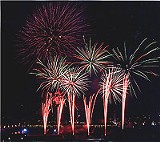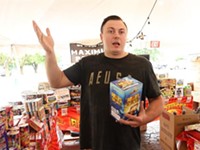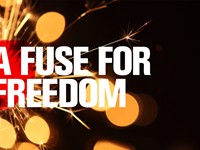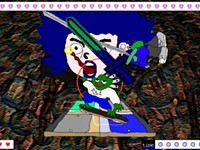[
{
"name": "500x250 Ad",
"insertPoint": "5",
"component": "15667920",
"parentWrapperClass": "",
"requiredCountToDisplay": "1"
}
]
In the wake of the World Trade Center's destruction, are celebratory fireworks still OK? More than ever. For one thing, fireworks can be used for Freudian sublimation: Take that, you rotten, sub-human terrorist scum --- POW! ZAPP! and BANG!! And just to show that our spirits (of ’76) aren’t dampened, nor our ability to appreciate discretionary beauty, take a look at this --- whoosh and OHHHHHH! Wasn't that gorgeous? Yes, fireworks are still pulse-quickeningly, heart-stoppingly --- and benignly --- gorgeous.
Often overlooked in the excitement are the people who shoot off the fireworks for our enjoyment. Who are they and what are they like? To find out, I talked to people at Young Explosives, Inc., the Victor company that puts on the Fourth of July show for the City of Rochester.
Sherry and Gary Michalko are veteran fireworks people. They have both worked on the Rochester fireworks show before --- and many others elsewhere. Gary is plant manager at the company's manufacturing and storage complex in the town of Canandaigua. Sherry married into the fireworks business and learned it from the ground up. This year while Gary is doing the Rochester show, Sherry will work a show in Elmira.
When I first met Sherry, her reply to my musty opener, "What do you do for excitement?" left me hopelessly one-upped. How could I top shooting off public fireworks for a living? By saying that I regularly face the mobs at the mall, and drive my car in heavy traffic? On the surface, Sherry is modest calm personified. But her steady gaze hints of steely nerves beneath, and maybe a reason to have them.
Gary warmed quickly to the subject of his work. He was in the middle of preparing for an out-of-town show and an intensity that I recognized crept into his voice. Before he got into fireworks he was a radio and club disk jockey in Elmira; I was in broadcasting for 20 years myself. Show deadlines have a way of sharpening your senses and perceptions.
When asked what he'd be doing if he weren't in fireworks, Gary couldn't think of anything. He says he loves his job --- both at the plant and as "firemaster" at many of Young’s shows.
Jim Young runs the company now. His father started it in 1949. Although Young Explosives manufactures and fabricates some of its own fireworks, Jim says the company is essentially in the entertainment business. His father learned the Italian style of pyrotechnics from the Grucci family, one of the most storied fireworks dynasties in America. This style features the loud salutes and the multiple-break shells that are Young specialties.
Gary has done shows with the Gruccis. "We learn from each other," he says. In George Plimpton's book, Fireworks, there’s a gripping account of how the Gruccis won the international fireworks competition at Monte Carlo. The reader is left gasping.
Most of the shows in this part of the state are done by Young Explosives. Jim did the Fairport Canal Days fireworks this year --- a first time for the village. There will no doubt be encores.
The Michalkos feel a special satisfaction when a show goes well --- when the sky is popping with peonies, chrysanthemums, palm trees, multiple-breaking shells of colored stars, when bone-shaking salutes are echoing off the landscape, and go-getters are chasing themselves excitedly across the sky --- when the crowds of thousands gasp and applaud from the bridges, balconies, riverside, and rooftops.
My father liked fireworks --- and explosives that blow things up, too. Harking back to my kid-hood, a boulder blocking a farm road sat in scornful challenge until my father decided to move it out of the way with Alfred Nobel’s contribution to the industrial revolution --- dynamite. He placed a stick of the stuff in a hole dug under the boulder, then, perhaps to test my mettle, let me tamp dirt into the hole on top of the dynamite. A car battery at the end of a 100-foot wire set off the firing cap, and that ol’ rock just rose up into the air and whooshed off into the bushes. The light in my father’s eye was unmistakable. Explosives fulfilled something primal in his nature.
Like racecar drivers, some people who use explosives in their jobs admit they like the rush that goes with the risk. After a while they get addicted to their own adrenaline. But by definition, coolness and deliberate caution must be primary characteristics of experienced demolitions experts. Same goes for pyrotechnicians, whether on the factory floor or at the shooting sites. Otherwise, they’d never get to be experienced.
I do have a mild bone to pick with the typical paradigm for fireworks displays --- the slow start, middle section with virtuoso variations, then (always) a climactic finale. Most human activities don’t follow that path. Daily life is, by definition, mundane, with perpetually postponed expectations and only rare realization of release and relief.
This, of course, is exactly why we like fireworks --- to see what life's excitements could be like without the restraints imposed by a mostly monotonous reality. Celebratory displays must be bigger than life. Unlike the cosmos, the BIG BANG has to come last.
There’s a rich vocabulary for pyrotechnic displays. The glossary in Plimpton’s book runs to 60 pages, crammed with terms like girondole, hummerstars, potatoes, garniture, black shells, flowerpots, and maroons. The last are very loud reports --- to “invigorate” the audience, as Japanese fireworks people would say. Fanciful names for oriental shells are also listed, like Monkeys Chasing Tigers out of Royal Palace. Such labels are usually toned down before export to a more prosaic America.
Fireworks technology is constantly expanding. Computers now make it possible to control firing sequences with precision --- heretofore an iffy proposition. The close timing makes choreography possible --- synchronizing fireworks with music. And new pattern shells keep coming out. This year Young's fireworks will feature hearts and smiley faces --- good palliatives for recent pain.
Explosives, of course, have a dark side. I have seen the perverse beauty of military fireworks --- tracer bullets like great fans of bright pearls, drifting upward lazily at twice the speed of sound, probing for enemy aircraft, transporting their tight packages of destruction, reaching up with delicate fingers of death. And the dirty bursts of ack-ack and the flipping-over-and-falling of giant aircraft midst the monstrous happenings of war.
But fireworks were used at celebrations long before someone thought of putting explosive powder in gun barrels to propel projectiles. The escalation to lethality is not a logical necessity.
The name, Young Explosives, is somewhat misleading. The company doesn’t make explosives other than for fireworks. It puts on 300 to 400 shows a year. They’ll do your wedding if you like. For this year’s Fourth they’ve got more than 30 shows scheduled on the same night.
In the Rochester display, 3,700 shells will be fired. Although the total tab including advertising and publicity will be $50,000, commercial sponsors are picking up $43,000 of that in eager response to the city’s pitch for a joyful celebration to offset the Trade Towers’ emotional pall.
During a show controlled by electrical panels, as most big shows now are, the mortars that fire the shells are used only once. Mortars are stovepipe-like tubes very similar to military mortars (one of which took a chunk out of my leg in a previous life).
Shows are designed with proprietary software on a PC in the Young company’s own studio, the music and shells synced to cues on a CD. For the Rochester show, the CD is prepared by one of the three radio stations that will simulcast the proceedings --- WBBF, WBEE and The Buzz. Once the sequence of shells is determined, and the fireworks components assembled, it takes two days to set up the equipment on site.
The show itself is run by a laptop computer. Signals are sent through firing wires to the squibs (electric matches) that ignite the lifting charges which send the shells high in the air. The lifting charges in turn ignite time fuses in the body of the shells, setting off the main charges at the peak of the trajectories. Except for two firing sites on the tops of buildings, the mortars will be shot from trailers.
Not the least of the work in preparing for a show is getting all the permits and licenses from federal, state, and local regulatory agencies. Some streets will be blocked off and a couple of Rochester Fire Department trucks will be standing by --- just in case. Ian Scott, an employee at Young, told me a show can go on in a driving rain --- with foil caps over the mortar mouths --- but the Fire Marshal can postpone a show for high winds.
Since the Trade Towers disaster, security in the fireworks business has been ramped up considerably. Employees of less than three years must now go through a thorough background check. Anybody from any of the 30 or so countries on the president’s terrorist list is meticulously scrutinized. A tendency to profile immigrants from these countries is inescapable.
Gary reminds us that it was agricultural fertilizer, not the black powder used in fireworks, that demolished the Federal Building in Oklahoma City, and in the Trade Towers attack, explosives weren’t used at all. But the public image of explosives generally tends to give the fireworks business a bad rep, and a bad rap.
Every year the employees at Young Explosives go though a mandatory full-day safety course. Everybody knows the rules and follows them. When I talked with Ian Scott at the plant, he showed me a grounded metal plate on the wall just inside the door that workers routinely touch to discharge static electricity.
The Young Explosives company has an excellent safety record, so their insurance rates, though steep, aren’t over the top. Making fireworks and shooting them off, Gary Michalko says, is less dangerous than clerking in a convenience store.
A personal postscript: the Fourth of July is a “patriotic” holiday. It celebrates America’s independence from England --- and the birth of democratic ideas that are still works in progress. Patriotism simply means loyalty to one’s people and the land where they (we) live. In my book that doesn’t mean unconditional loyalty, not “my country, right or wrong,” but a thoughtful loyalty that acknowledges problems and tries to fix them.
In America, we the people are diverse by design, so loyalty gets pretty complex. The land we live on, too, is diverse, and remarkably beautiful. If we all try hard enough, it can stay beautiful. Wanting to protect it, and to brag a little about the best of what we’ve got, and what we’ve accomplished in 225 years, is, to me, perfectly reasonable.
But a terrible truth of the 9/11 catastrophe is that to make their point the attackers played right into our fascination for violence --- as if to say, “OK, if you people get off on violence so much --- as shown so gratuitously in your movies and TV (which you gladly export to the rest of the world) --- we'll give you violence. Take a look at THIS! And THIS!” Nobody could not look.
Extremists give patriotism a bad name, as do the anti-patriots who sneer at any pride of home or place. I myself am an expert on patriotism. My neighbors (read draft board) sent me off to war. They gave me a gun and told me to go to a faraway land and shoot people. I was too young to understand why I was there.
Many years later, I’m still too young to fully understand, except that it does seem to be OK to want protect the things we value --- as best we can. For my money, our Fourth of July marks one of the most remarkable events in human history, and it’s worth celebrating --- even if the rockets’ red glare and the bombs bursting in air,as in our national anthem,don’t represent the best of what we have to offer.
Let the fireworks begin!
© Warren Wightman, 2002
Speaking of...
Latest in Culture
More by Warren Wightman
-
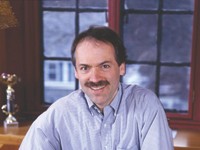
Will Shortz is not a fiend
Dec 14, 2005 -

Dash and swoop
Jul 21, 2004 -

A concise handbook of astrology
Dec 11, 2002 - More »
